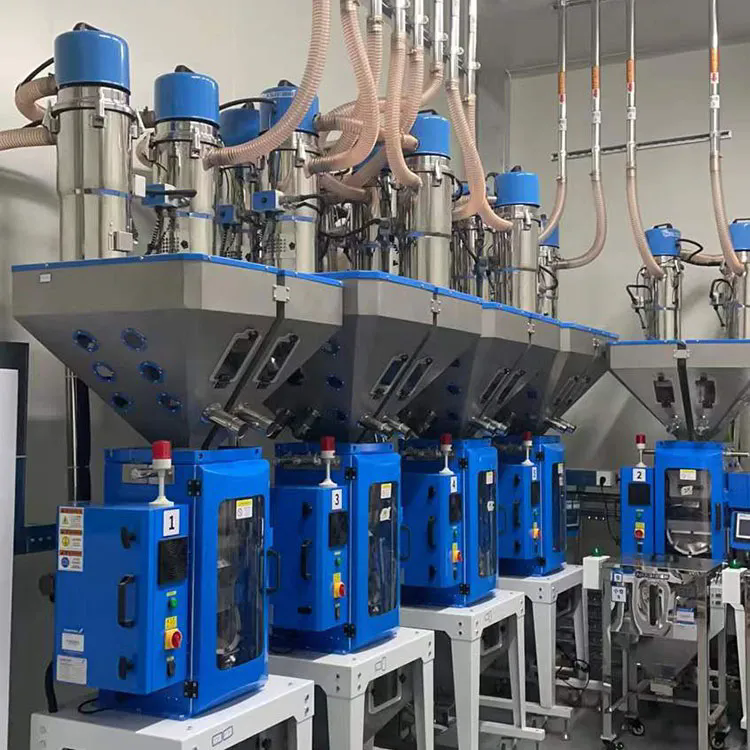What Are Central Feeding Systems and How Can They Revolutionize Your Production Process?
2024-12-07
In industries such as plastics, food processing, and manufacturing, the efficiency and smooth operation of the production line are crucial for maintaining high output and minimizing waste. One solution that has gained significant popularity in recent years is the central feeding system. But what exactly is a central feeding system, and how can it revolutionize your production process? In this blog, we will dive into the details of this technology, its benefits, and how it can enhance the overall efficiency of your production operations.
What Is a Central Feeding System?
A central feeding system (CFS) is a type of automated material handling system used to transport raw materials to multiple production lines or machines from a central location. Instead of feeding each machine individually, the materials are stored in a central unit (such as a silo, hopper, or feeder), then distributed to various parts of the production process via a network of pipes, conveyors, or other transportation mechanisms.
Central feeding systems are widely used in industries where high volumes of materials, such as pellets, powders, or granules, are used in the manufacturing process. These systems can be integrated into a variety of production lines, including injection molding, extrusion, packaging, and more.
How Do Central Feeding Systems Work?
The core function of a central feeding system is to ensure that materials are efficiently fed to different production machines in a timely and controlled manner. Here’s how the process typically works:
1. Material Collection: Raw materials (e.g., plastic pellets, grains, powders) are collected and stored in a central location, often in bulk storage containers like silos or hoppers.
2. Transportation: Using a network of conveyors, pipes, or augers, the material is transported from the central storage to different machines or production areas.
3. Feeding to Machines: The system regulates and distributes the material to various machines, ensuring each machine receives the correct amount of material. This is often done through a combination of gravity, screw feeders, vibratory feeders, or pneumatic conveyors.
4. Automation and Control: The central feeding system is typically controlled via an automated system, which monitors and adjusts the flow of material based on real-time needs. Sensors, flow meters, and automated controls ensure a continuous and precise supply of material.
Benefits of Central Feeding Systems
1. Increased Efficiency and Reduced Downtime
One of the biggest advantages of a central feeding system is its ability to streamline the production process by eliminating the need for multiple material handling units at each individual machine. This centralized approach minimizes the chances of material shortage, reduces handling time, and ensures that production lines remain operational for longer periods without interruptions. Additionally, with automated controls, the system ensures that materials are fed precisely when needed, further reducing downtime caused by manual feeding errors.
2. Cost Savings
While the initial investment in a central feeding system can be significant, the long-term cost savings are substantial. Centralized material storage and feeding reduce the need for individual material handling equipment at each machine, which can be expensive to maintain. Moreover, these systems help minimize material waste by ensuring the right amount of material is supplied at all times. This precise control over material flow leads to significant savings in terms of raw material consumption.
3. Space Optimization
A central feeding system can help optimize factory floor space by eliminating the need for individual storage units and feeding equipment at each workstation. This allows companies to free up valuable space for other operations or to expand their production capacity without increasing the overall footprint of the facility.
4. Improved Material Quality Control
Central feeding systems are designed to transport materials gently and uniformly, reducing the likelihood of material degradation during handling. With precise control over the material supply, these systems also ensure that the correct material is fed to each machine, maintaining consistent quality across the entire production process.
5. Enhanced Safety
In industries where materials may be hazardous, such as those involving chemicals or fine powders, central feeding systems can help improve safety by reducing manual handling and minimizing direct exposure to these materials. Automated feeding systems reduce the risk of workplace injuries associated with manual lifting, handling, and transporting heavy or dangerous materials.
6. Scalability and Flexibility
Central feeding systems can be designed to accommodate a variety of materials and production requirements. Whether you’re dealing with high volumes of small materials like pellets or larger, bulkier products, central feeding systems can be customized to meet specific needs. Additionally, these systems can be easily scaled up or down as production requirements change, making them ideal for growing businesses or manufacturers with fluctuating demands.
7. Reduced Labor Costs
Automation in central feeding systems reduces the need for manual labor to transport and feed materials. This not only reduces labor costs but also allows employees to focus on more critical tasks, such as quality control or machine maintenance, further improving productivity.
Applications of Central Feeding Systems
Central feeding systems are versatile and can be applied in various industries, including:
- Plastics and Injection Molding: For feeding granules or pellets to injection molding machines, central feeding systems help ensure a continuous, uniform supply of material.
- Food Processing: Central feeding systems can be used to transport ingredients like grains, powders, or liquids to various parts of a food production line.
- Pharmaceuticals: In the pharmaceutical industry, central feeding systems are used to handle powders, tablets, or capsules in the manufacturing of medications.
- Packaging: Central feeding systems can help automate the movement of materials for packaging, reducing manual labor and improving efficiency.
How to Choose the Right Central Feeding System
When selecting a central feeding system for your facility, there are several factors to consider:
- Material Type: Ensure that the system is compatible with the type of material you are using, whether it's powders, pellets, or bulk solids.
- Production Volume: Consider the volume of material you need to transport daily to ensure the system can meet your throughput requirements.
- Space and Layout: Analyze your factory floor space to ensure the system fits your available area and integrates seamlessly into your existing workflow.
- Automation Needs: Choose a system with the right level of automation to meet your production needs. Advanced systems may include sensors and data analytics for real-time monitoring and optimization.
Conclusion: Is a Central Feeding System the Right Choice for Your Business?
A central feeding system can significantly enhance the efficiency, safety, and profitability of your production operations. By automating the material handling process, reducing waste, and optimizing space, these systems offer a comprehensive solution for businesses looking to streamline their production processes and improve overall productivity.
If you’re looking to take your manufacturing operations to the next level, a central feeding system could be just what you need. Whether you’re in plastics, food processing, or another industry, these systems can help you reduce costs, enhance product quality, and keep your operations running smoothly.



